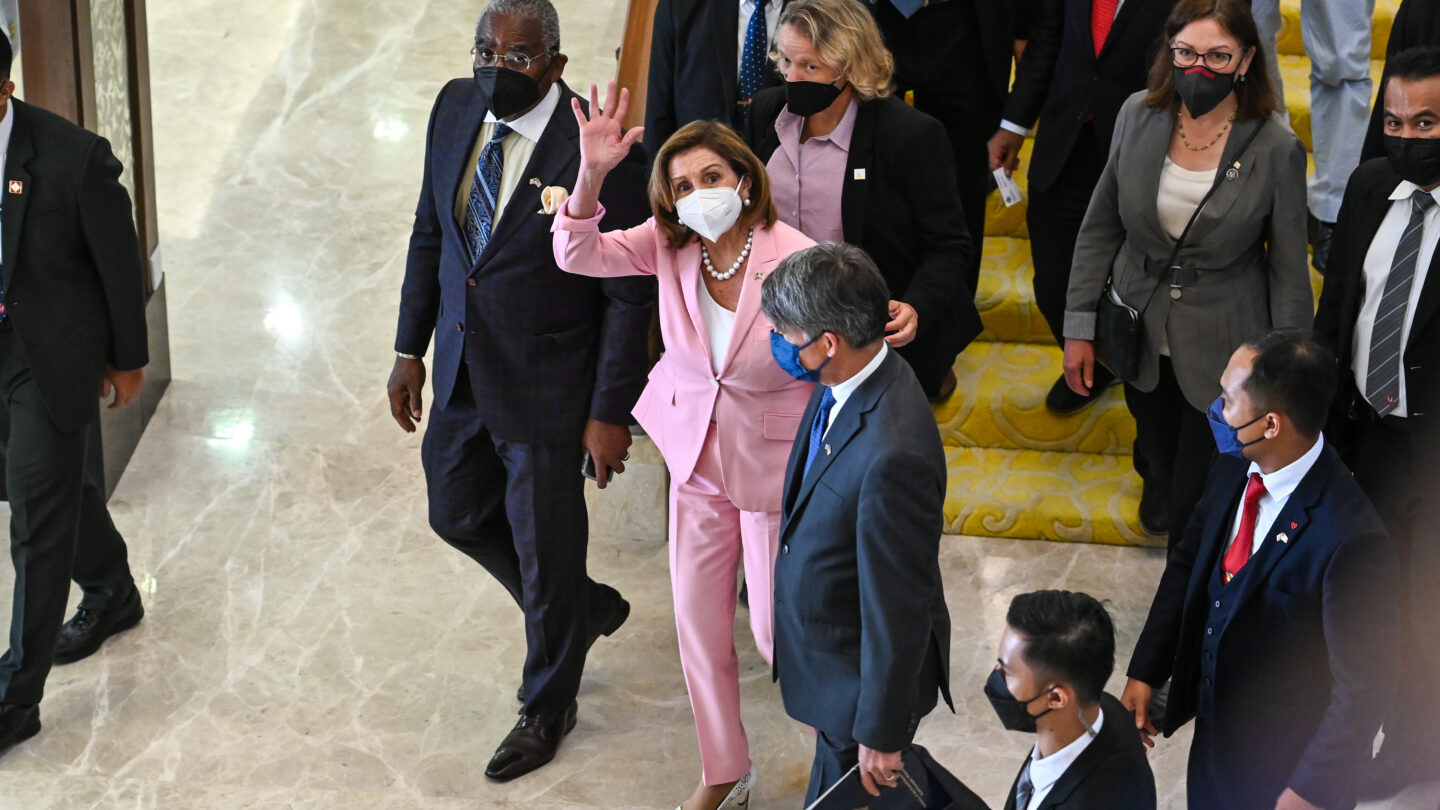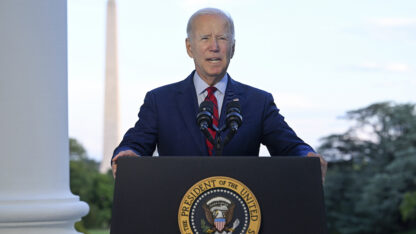U.S. House Speaker Nancy Pelosi arrived in Taiwan on Tuesday night, becoming the highest-ranking American official to visit the self-ruled island that is claimed by China in 25 years.
Pelosi’s visit has triggered increased tensions between China and the United States. China claims Taiwan as part of its territory, to be annexed by force if necessary, and views visits by foreign government officials as recognition of the island’s sovereignty.
China had warned of “resolute and strong measures” if Pelosi went ahead with the trip. The Biden administration did not explicitly urge her to call it off, while seeking to assure Beijing it would not signal any change in U.S. policy on Taiwan.
Chinese Foreign Minister Wang Yi said Washington’s betrayal “on the Taiwan issue is bankrupting its national credibility.”
“Some American politicians are playing with fire on the issue of Taiwan,” Wang said in a statement. “This will definitely not have a good outcome … the exposure of America’s bullying face again shows it as the world’s biggest saboteur of peace.”
A plane carrying Pelosi and her delegation left Malaysia on Tuesday after a brief stop that included a working lunch with Prime Minister Ismail Sabri Yaakob. Local media in Taiwan reported that Pelosi would arrive on Tuesday night. The United Daily News, Liberty Times and China Times — Taiwan’s three largest national newspapers — cited unidentified sources as saying she would spend the night in Taiwan.
Taiwan’s Foreign Ministry declined to comment. Premier Su Tseng-chang didn’t explicitly confirm Pelosi’s visit, but said Tuesday that “any foreign guests and friendly lawmakers” are “very much welcome.”
Barricades were erected outside the Grand Hyatt Hotel in Taipei where Pelosi was expected to stay amid heightened security. Two buildings in the capital lit up LED displays with words of welcome, including the iconic Taipei 101 building, which said “Welcome to Taiwan, Speaker Pelosi.”
China, which regards Taiwan as a renegade province to be annexed by force if necessary, has repeatedly warned of retaliation if Pelosi visits, saying its military will “never sit idly by.”
“The U.S. and Taiwan have colluded to make provocations first, and China has only been compelled to act out of self-defense,” Chinese Foreign Ministry spokesperson Hua Chunying told reporters Tuesday in Beijing.
Hua said China has been in constant communication with the U.S. and made clear “how dangerous it would be if the visit actually happens.” Any countermeasures China take will be “justified and necessary” in the face of Washington’s “unscrupulous behavior,” she said.
Shortly before Pelosi was due to arrive, Chinese state media said Chinese SU-35 fighter jets were “crossing” the Taiwan Strait, the body of water that separates mainland China and Taiwan. It wasn’t immediately clear where they were headed or what they planned to do.
Unspecified hackers launched a cyberattack on the Taiwanese Presidential Office’s website, making it temporarily unavailable Tuesday evening. The Presidential Office said the website was restored shortly after the attack, which overwhelmed it with traffic.
“China thinks by launching a multi-domain pressure campaign against Taiwan, the people of Taiwan will be be intimidated. But they are wrong,” Wang Ting-yu, a legislator with the Democratic Progressive Party, said on Twitter in response to the attack.
China’s military threats have driven concerns of a new crisis in the 100-mile (140-kilometer) -wide Taiwan Strait that could roil global markets and supply chains.
The White House on Monday decried Beijing’s rhetoric, saying the U.S. has no interest in deepening tensions with China and “will not take the bait or engage in saber rattling.”
White House National Security Council spokesperson John Kirby underscored that the decision whether to visit Taiwan was ultimately Pelosi’s. He noted that members of Congress have routinely visited the island over the years.
Kirby said administration officials are concerned that Beijing could use the visit as an excuse to take provocative retaliatory steps, including military action such as firing missiles in the Taiwan Strait or around Taiwan, or flying sorties into the island’s airspace and carrying out large-scale naval exercises in the strait.
“Put simply, there is no reason for Beijing to turn a potential visit consistent with long-standing U.S. policy into some sort of crisis or use it as a pretext to increase aggressive military activity in or around the Taiwan Strait,” Kirby said.
U.S. officials have said the U.S. military would increase its movement of forces and assets in the Indo-Pacific region if Pelosi visits Taiwan. U.S. Navy aircraft carrier USS Ronald Reagan and its strike group were in the Philippine Sea on Monday, according to officials who spoke on condition of anonymity to discuss military operations.
The Reagan, the cruiser USS Antietam and the destroyer USS Higgins left Singapore after a port visit and moved north to their homeport in Japan. The carrier has an array of aircraft, including F/A-18 fighter jets and helicopters, on board as well as sophisticated radar systems and other weapons.
Taiwan and China split in 1949 after the Communists won a civil war on the mainland. The U.S. maintains informal relations and defense ties with Taiwan even as it recognizes Beijing as the government of China.
Beijing sees official American contact with Taiwan as encouragement to make the island’s decades-old de facto independence permanent, a step U.S. leaders say they don’t support. Pelosi, head of one of three branches of the U.S. government, would be the highest-ranking elected American official to visit Taiwan since then-Speaker Newt Gingrich in 1997.
The flight tracking site Flightradar24 said Pelosi’s aircraft, a U.S. Air Force Boeing C-40C, was the most tracked in the world on Tuesday evening with 300,000 viewers. The plane took a roundabout route, flying east over Indonesia rather than directly over the South China Sea.
Pelosi has used her position in the U.S. Congress as an emissary for the U.S. on the global stage. She has long challenged China on human rights, including in 2009 when she hand-delivered a letter to then-President Hu Jintao calling for the release of political prisoners. She had sought to visit Taiwan’s island democracy earlier this year before testing positive for COVID-19.
Pelosi kicked off her Asian tour in Singapore on Monday as her possible visit to Taiwan sparked jitters in the region.
Singapore Prime Minister Lee Hsien Loong “highlighted the importance of stable U.S.-China relations for regional peace and security” during talks with Pelosi, the city-state’s Foreign Ministry said. This was echoed by Japanese Foreign Minister Yoshimasa Hayashi in Tokyo, who said stable ties between the two rival powers “are extremely important for the international community as well.”
The Philippines urged the U.S. and China to be “responsible actors” in the region. “It is important for the U.S. and China to ensure continuing communication to avoid any miscalculation and further escalation of tensions,” said Foreign Affairs spokesperson Teresita Daza.
China has been steadily ratcheting up diplomatic and military pressure on Taiwan. China cut off all contact with Taiwan’s government in 2016 after President Tsai Ing-wen refused to endorse its claim that the island and mainland together make up a single Chinese nation, with the Communist regime in Beijing being the sole legitimate government.
Pelosi is to travel to Japan and South Korea later this week.









